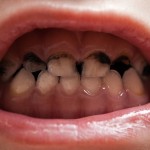
Dental caries is a major dental public health problem. A number of studies have demonstrated the effectiveness of silver diamine fluoride (SDF) in arresting caries. SDF is an affordable therapy that is easy to apply and does not require dental equipment so can be used in non-clinical situations.
The aim of this review was to evaluate the efficacy of silver diamine fluoride (SDF) in controlling caries progression in children when compared with active treatments or placebos
Methods
Searches were conducted in the PunMed, Scopus, Web of Science, the Latin American and Caribbean Health Sciences Literature database (LILACS), the Brazilian Library in Dentistry (BBO) and the Cochrane Library databases with no restrictions on language or date of publication. This was supplemented by searches of the Abstracts of the International Association for Dental Research and its regional divisions he database System for Information on Grey Literature in Europe and Google Scholar, ProQuest Dissertations and Theses, Periódicos Capes Theses database, Current Controlled Trials, International Clinical Trials Registry Platform the ClinicalTrials.gov, Rebec (www.rebec.gov.br) and EU Clinical Trials Register (https://www.clinicaltrialsregister.eu).
Randomised controlled trials (RCTs) of parallel design comparing SDF application with other active treatments or placebo in arresting carious lesions in primary teeth or first permanent molars of children were considered. Two reviewers selected studies with 3 reviewers abstracting data. Risk of bias was assessed using the Cochrane risk of bias tool. The GRADE approach was used to assess the quality of the evidence for each outcome across the studies. Meta-analysis was performed on studies considered at low risk of bias.
Results
- 11 studies were included
- Sample sizes ranged from 60-1,016 patients
- SDF concentration and application protocols varied between studies
- Follow up periods ranged from 12-36 months.
- 5 studies were considered to be at low risk of bias, 4 at high risk at 2 at unclear risk.
- 4 studies with similar outcomes contributed to the meta-analysis.
- Comparing SDF v active treatment (2 studies); Risk ratio (RR) = 1.66 (95%CI; 1.41 – 1.96)
- Comparing SDF v placebo (2 studies);RR = 2.54 (95%CI; 1.67 – 3.85)
Conclusions
The authors concluded: –
SDF is more effective than other active treatments or placebo for caries arrestment in primary teeth. The body of evidence was of high quality for primary teeth. There is not enough evidence to draw a conclusion about caries arrestment in first permanent molars.
Comments
The review has undertaken an extensive search to identify relevant studies. They have also restricted the inclusion criteria to RCTs with a duration on more than 12 months. We have previously reported on an earlier systematic review of this question (Dental Elf – 22nd Aug 2016). That review included all prospective clinical studies ( 19 in all) compared with the RCTs only in this review. While this review shows the effectiveness of SDF in arresting caries it does have the limitation of staining the teeth black which has implications for its acceptability to patients.
Links
Primary Paper
Chibinski AC, Wambier LM, Feltrin J, Loguercio AD, Wambier DS, Reis A. Silver Diamine Fluoride Has Efficacy in Controlling Caries Progression in Primary Teeth:A Systematic Review and Meta-Analysis. Caries Res. 2017;51(5):527-541. doi:10.1159/000478668. Epub 2017 Oct 4. PubMed PMID: 28972954.
Other references
Original review protocol on PROSPERO
Dental Elf – 3rd Oct 2017
Silver diamine fluoride: 38% more effective than 12% in arresting caries
Dental Elf – 22nd Aug 2016

[…] post Silver diamine fluoride for caries in primary teeth appeared first on National Elf […]